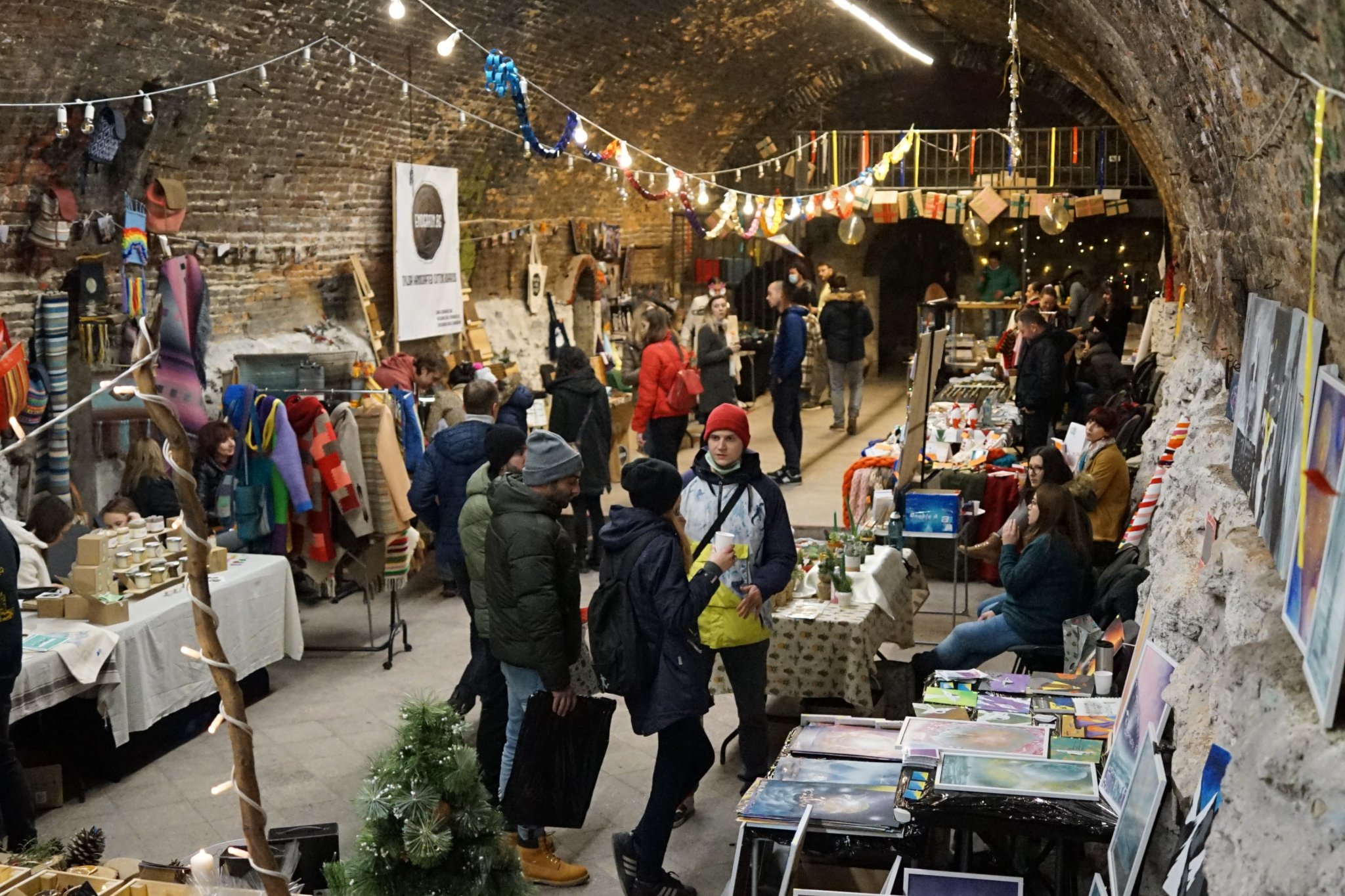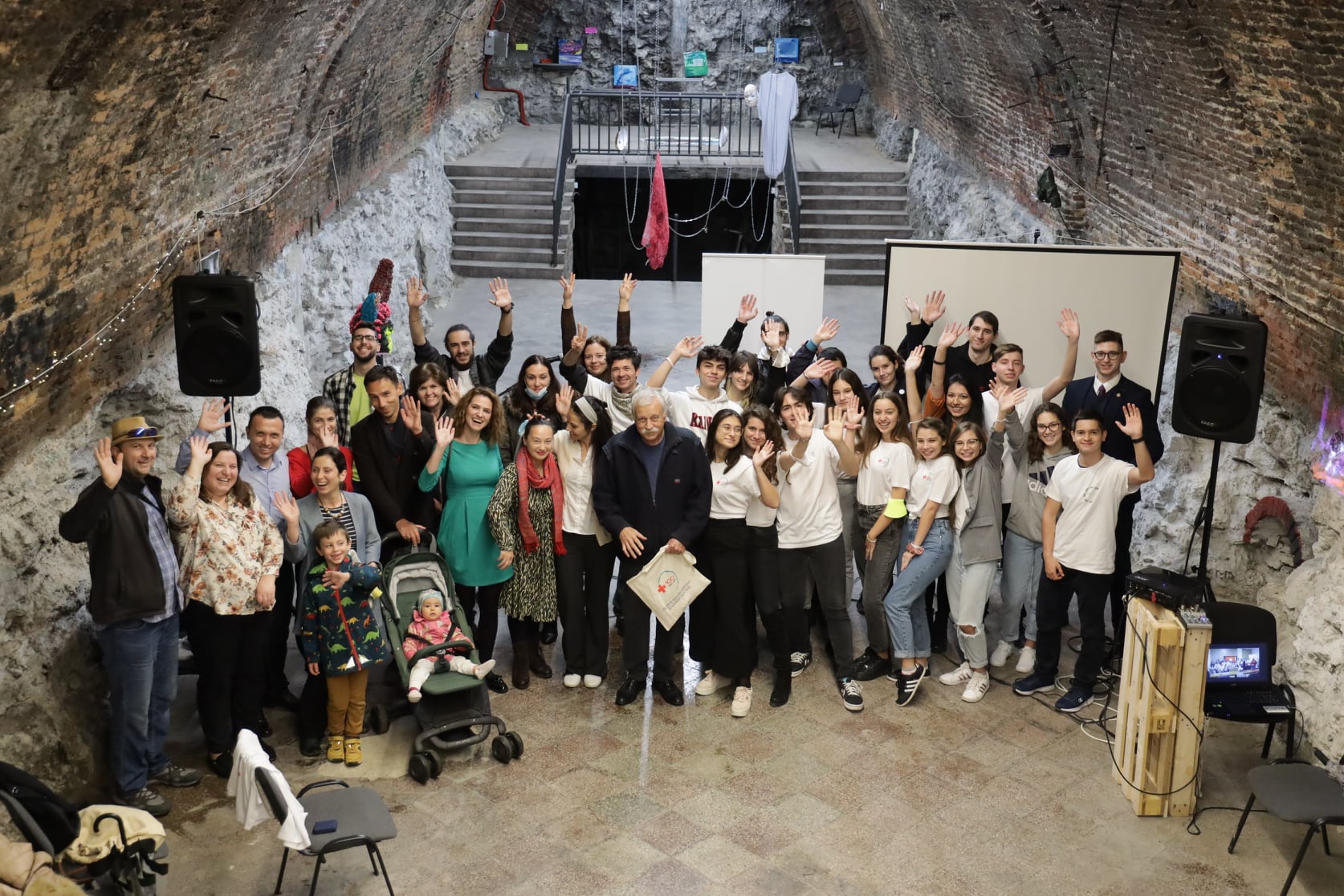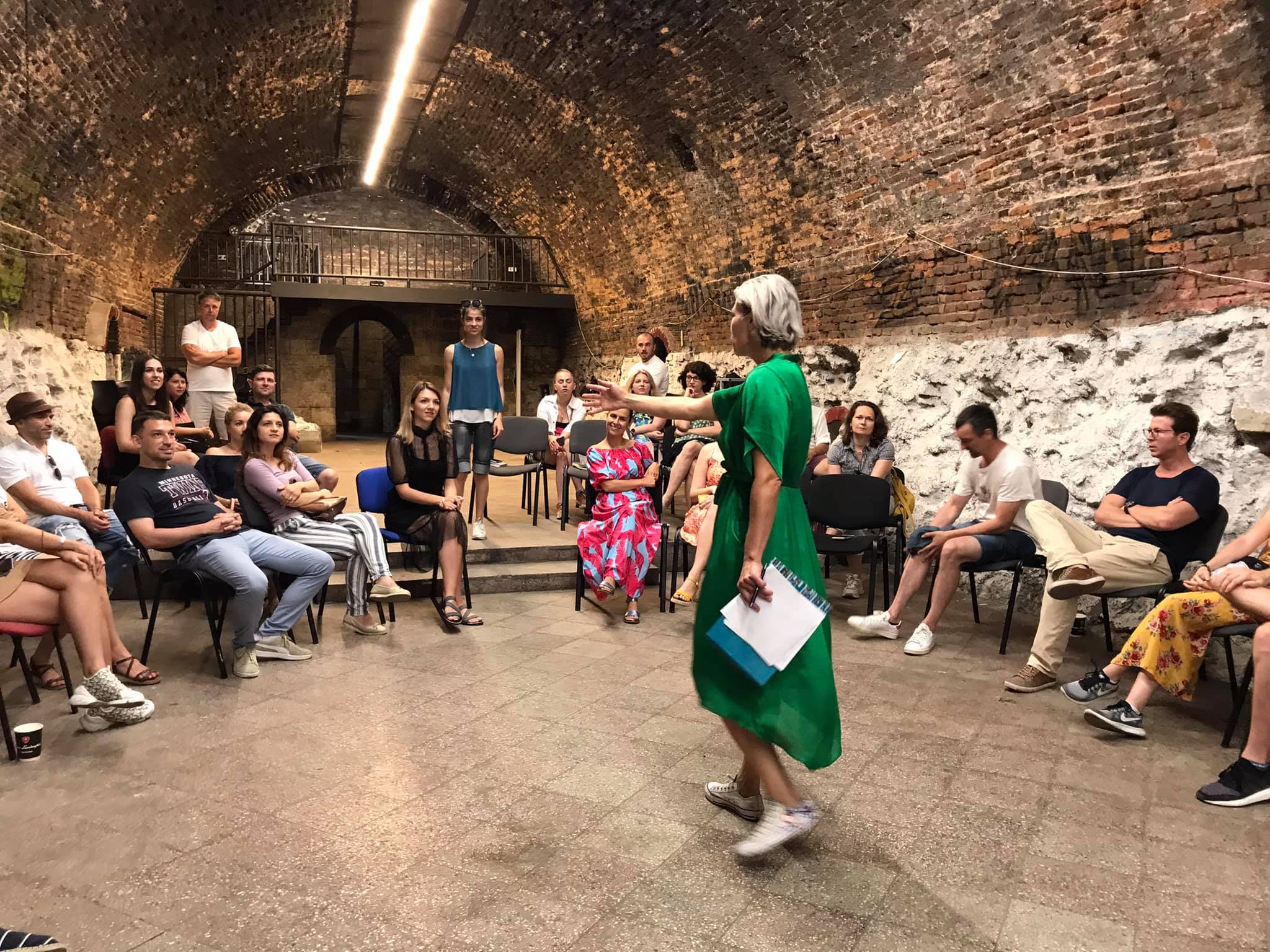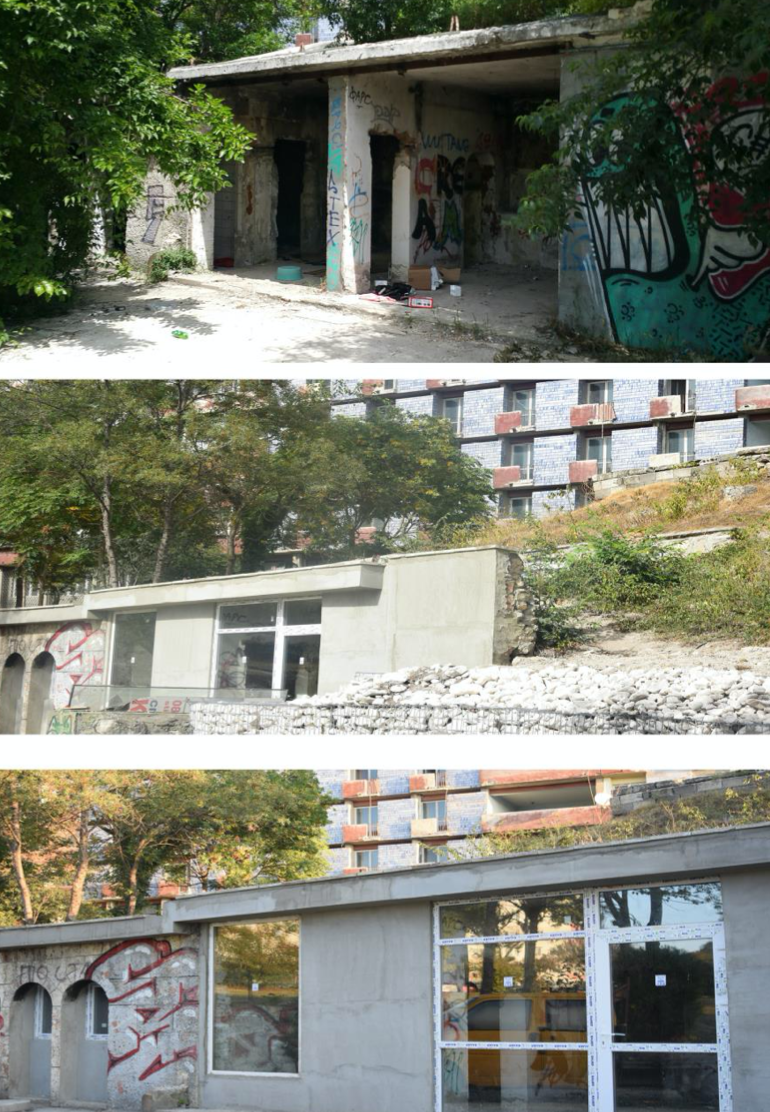ReBonkers, it is a 200-year-old Ottoman armory, that in the 90s was an underground music club. One of the first after Communism, it shaped a generation’s attitudes to free expression and global culture. Abandoned in the 2000’, it marginalised the surrounding area. In 2017 Varna European Youth Capital Association was entrusted by the City of Varna to turn the site into a place for youth and art. It is unique story of revitalisation through public inclusion, sustainability, and art.
ReBonkers is a new space for art and culture in Varna, a unique story of revitalisation through public inclusion, sustainability, and art. Formerly known as Bonkers, it is a 200-year-old Ottoman armory transformed from a marginal spot to a promising cultural venue. This revival involved significant effort in construction and landscaping, achieved entirely by community action and private donation. It was the notoriety of Bonkers as a revolutionary underground music club in the 90s, that started this process in motion.
As one of the first music scenes after Communism, it shaped a generation’s attitudes to free expression, liberalisation, and global culture, and was instrumental in remaking the industry in post-Socialist Bulgaria. The present name, ReBonkers, is an homage to this heritage.
Two decades after its heyday, the building was abandoned, left to squatters. Its physical ruins and increasing marginalisation reduced the security and quality of life of the surrounding area.
In 2017, the non-profit Varna European Youth Capital Association, together with Talyana Association, initiated Bonker’s restoration renewing the deteriorated urban area into the once booming place of youth and culture. Building on that heritage, and activating the preexisting audience, the initiative managed to collect donations, free labor, and materials, thus securing the perimeter, and allowing restoration of the building and its infrastructure.
To create content and revive its audience, we had to engage a broad section of people, fostering inter-generational dialogue about transferring cultural notions. The challenges of the early 90s have long been replaced, as have been the circumstances of cultural production. We used practices of social inclusion to activate different stakeholders, resulting in a unique translation of priorities derived from the past and adapted to the present. Today, ReBonkers is in the middle of its first official season, with an ambitious program of events.
Please highlight how the project can be exemplary in this context
While revitalisation was conducted by capitalising on the venue’s cultural heritage, consolidating the program’s strategy, and delivering content, required additional funding. Achieving this required recruiting a team through stakeholder meetings with representatives of different cultural fields and generations. After adopting this strategy, we applied for funding from relevant local and national institutions.
Our project developed a constant engagement with the audience. During reconstruction, we conducted public debates, actively working with local media and cultural operators to foster dialogue. It helped prepare the audience for the return of Bonkers. The early involvement of the public contributed to the diversity of our program. The results of the events in the test season was part of the reason why ReBonkers was successfully funded for 2022. By continuing this dialogue with the audience, we can continue to deliver content that is successfully realised in the community. ReBonkers is an excellent demonstration of the sustainability of public centered models of cultural production.
Our programming is inclusive and we accommodate different types of content. Keeping in mind that cultural venues are not just places of entertainment, but are also identity-building spaces, we postulated a number of values that needed to be maintained and we consolidated the program strategy around urban ecology and sustainability. These values match those of the New European Bauhaus: inclusion, aesthetics, and sustainability.
ReBonkers, while an art place, is at the same time a workshop for urban greenification. Large number of the events are focused on the environment and on innovative practical solutions. This building is the only one in Varna with a natural green roof which provides a certain constant temperature inside allowing energy-efficient, yearlong operation.
Build.Rebuild.ReBonkers.
Make.Remake.ReBonkers.
Cycle.Recycle.ReBonkers
Please highlight how the project can be exemplary in this context
In terms of content, ReBonkers is a cultural venue with aesthetics as one of its focal points. In terms of a project of urban revitalisation, the end goal was to improve both the quality of life and the aesthetics of the area.
A key objective for the renovation of this inspiring 200-year-old building was to preserve, as much as possible, its previous look. This decision resulted in the creation of a place with tangible authenticity. One can still see ageing graffiti on its walls from the building’s club period, as well as the signs of indoor fires during its abandoned period, accenting its deep cultural heritage and long history. Even when empty, the main hall is inspiring, with its curved roof, old ceramic bricks, and the signs of long and exhaustive use. The place is an important historical venue in itself, and this sentiment was intentionally planned during the renovation stage.
On the outside, we have established a fenced perimeter which now hosts the garden of ReBonkers, an ongoing project which involves not only gardening, but also art installations, public projects like a small skate pool, and a laboratory for greenification and permaculture, a program that started this year.
Aesthetics for us is not just an outlook strategy but a focal point of urban interaction. Bonkers has been reincarnated as an art center with a persistent program of artistic content, demonstrating how aesthetics is both a means for including the public as well as a strategy for actively improving our urban surroundings.
Play.Replay.ReBonkers.
Turn.Return.ReBonkers.
Search.Research.ReBonkers.
Please highlight how the project can be exemplary in this context
Inclusion was not only a key objective of the process but was also instrumental for its realisation at the rebuilding stage and is now even more important as a mechanism for content generation. As an initiative modelled after the idea “by the people, for the people”, ReBonkers is a project made possible by the flexibility of activities planned in the context of citizen engagement, co-design, public dialogue, and community driven strategy. As a result, most of the program content is free and accessible to a wide range of audiences.
Besides the involvement of the general audience, a special effort has been made to include minorities, kids at risk, and other underrepresented groups in the city. We have already conducted events such as a free 3D mapping workshop with the participation of minority students (as part of Water Tower Art Residency 2021, realised with the support of the US Embassy in Bulgaria). We persistently collaborate with local social inclusion projects by hiring youths at risk for part time jobs.
In terms of equality, ReBonkers has a strategy for recruiting team members and participating in projects through interacting with the general audience. This is a strategy for equal opportunity, as we literally give the stage to representatives of very different social and cultural groups. Amongst our team members and collaborators, we have people with different sexual orientations, ages, and genders.
Further, as we see ReBonkers as a cultural venue contributing to the building of social norms and practices in the city, we firmly stand behind the values of inclusion and equality. Such values are also represented in our cultural program, by our guest artists, and in our presented topics.
Mix.Remix.ReBonkers.
Mind.Remind.ReBonkers.
Please highlight how this approach can be exemplary
The positive outcomes of this project are based on the integration of inclusion, sustainability, and aesthetics. The revitalisation was mainly achieved through cultural agency. Using the collective memory of “Bonkers”, Varna European Youth Capital Association managed to find support for planning and implementing the project. The successful outcome with ReBonkers was the result of multisectoral dialogue between stakeholders, cultural agents, and the larger community.
The use of cultural heritage as a tool for revival required a co-design model, engaging citizens and non-profits. Activating cultural heritage as a rebuilding force is an excellent example of how, by means of broad social inclusion, tangible improvement for an entire area can be achieved. This has social and aesthetic dimensions, as it fills real gaps in the city’s cultural map, while beautifying and improving the area.
Yet numerous interested parties’ desires were homogenised by the idea of sustainability. The diverse stakes of ReBonkers, in term of utilisation and content, had to remain open and yet be unified by a common idea. Thus, the idea of a cultural hub devoted to sustainability and urban greenification was created. The diverse program of events, from movie projections to concerts, workshops, and lectures, were united under the common values of improvement of the environment, greenification of the city, and the betterment of citizen’s health and well-being.
The final shape of the project coalesced into a multidisciplinary cultural hub. The new format of ReBonkers is a way of translating the heritage of the legendary music scene into present practices by romanticising the past. This strategy proved efficient in that it activated a broader scope of audiences through a cross-generational transition of cultural heritage. This fostered a more confident approach to discussing the present-day cultural identity of the city, between global processes and local empowerment.
Unite.Reunite.Rebonkers.
The rebuilding results are already evident in the building’s transformation (see presentation 1). The site was thoroughly cleaned and secured. The building was return to functionality with new infrastructure, sanitary facilities, a fenced garden, and improved accessibility. As a result, the overall look of the surrounding area has greatly improved, the fenced perimeter is well lit, improving the walkability of the adjacent neighbourhood, as well as improving access and allowing for better conditions for outdoor activities.
Testament for this comes from the almost daily visits from neighbours expressing their gratefulness for this transition. They also expressed interest in the program of ReBonkers and the degree of open access to our facilities and garden.
Today the venue has a completely new identity and a full staff recruited through public interaction. A good measure of its efficiency is the financial support already granted by the National Fund of Culture in Bulgaria in support of the program for 2022.
Another measurable outcome is the intensive interest of the public to the first wave of events held during the test season (Fall 2021) and the present season (2022). The interest, no doubt, has accumulated as a result of the active public dialogue throughout the rebuilding process, as well as the cultural heritage of ReBonkers from the 90s, and the alternative cultural programming designed to fill gaps in the city’s event calendar.
Our social media outreach peaked at 20 thousand interactions per event, and physical visitors have often challenged the capacity of the venue. (See presentation 2)
Another indicative result is the persistent media interest and support at both local and national levels. The media carries the inspiring story of ReBonkers’ transformation and regularly reports on our program and activities.
A final testament of this well-realised project is the ambitious art calendar for Summer Season 2022
Think.Rethink.ReBonkers.
Please also explain the benefits that derived from their involvement.
As described in the above sections, the entire project for the revitalisation of ReBonkers has been designed and implemented by civil society organisations and thanks to an active strategy of public involvement. The involvement of citizens was instrumental to the rebuilding process, both for informing a new vision of the location and by directly contributing to its realisation.
In the post-rebuilding phase, including program strategy, identity, and the delivery of content, the role of the wide city audience, as well as specific civil society organisations, was fundamental for deciding on the future nature and model for the operation. The choices for ideological pillars of the venue, such as inclusiveness and sustainability, came as a result of multiple discussions, focus groups, and collaborative activities.
Finally, the idea for the future sustainability of the project relies heavily on its interaction with the public as both a source for content and as a validation of the program through active participation. This cycle of information and participation is the only path to sustainability for a cultural, non-profit venue. The public’s interest is the main measurable outcome for the successful fulfilment of funded programs. In such venues, maintaining this active dialogue is the only path to sustainability for the foreseeable future.
As a cultural institution, ReBonkers offers a number of events centered around the well-being of the citizens of Varna, including seminars and workshops devoted to the walkability of the city, to urban life and nature, to discussions about optimising and expanding pedestrian areas and bicycle paths.
The topic of gender equality and the empowerment of women is well-suited to our program for 2022, which includes the curatorial debut of a contemporary artist from Varna, in a capacity building program of intergenerational exchanges between female artists.
One of the main topics of the workshops for this year is devoted to sustainability through innovation. In the spring, we plan an expo of small and medium scale innovations in recycling practices and other innovations for sustainable practices. In the fall, we have an entire month planned around the topic of green architecture and green cities, including practical workshops and seminars.
Recycling is the big topic of the year, represented both in exhibitions and in interactive events. We will show to the city audience different ways to include recycling in the everyday life, including as a form of art and as a means for directly improving the world around us.
We already work actively toward engaging minorities in our activities as both participants and as part of the audience. This summer, we have planned a program with “Mini Art Fest Foundation (Sofia)” specialising in circuses as tools for integration, interaction, and education in underrepresented communities and communities with special needs and at-risk youth.
We have already concluded a project (2019) on ocean sustainability, namely the effort of clearing the sea from old fishing nets that pose a threat to sea mammals and other creatures. We plan on expanding this project by further promoting this activity.
Last but not least, we host the International Red Cross Film Festival, which addresses the humanitarian challenges the world faces.
Revitalisation through cultural agency
The main reason why the team found support from the community to successfully restore the space was the activation of collective memory and nostalgia based on the heritage of Bonkers. This proved to be a fundamental mechanism for the realisation of the rebuilding, entirely driven by the community, local donations, and practical involvement by the general public.
To benefit nostalgia is one thing, but to breathe life into a new place requires a translation of that heritage into contemporary settings. This was conducted by a sound analysis of the needs of the cultural sector and various settings for the cross-generational transmission of values, and discussions of the identified needs. This analysis painted a picture of certain defects in the local scene, namely, in the sector of independent arts, conceptual and performative arts, and grass root youth culture. These deficits were identified after a careful analysis of the existing cultural program of the city, and were then compared to the role the former Bonkers music club played in the scene. The evident overlapping shaped the main pillar of the program - independent arts
Taking a stand on global issues
To link the contemporary audience with a new cultural hub required an identity aligned with the needs and problems of our present world. Through public dialogues we united around the issues of the environment and well-being as the most pressing topics for the city of Varna.
A final innovation regards the consolidation of the place into a location with a coherent identity without losing the diverse input of the public. We finalised our program around 3 main pillars - independent stage, contemporary art, and sustainable development. This threefold approach communicates the interlinkage between all these topics, and yet accommodates the interests of the audience by guiding them to choose the type of event most appealing at the individual level.
Please provide clear documentation, communication of methodology and principles in this context.
The turbulence of the transition period has left the former Eastern Bloc with a vast number of decaying buildings. “Brown sites” are a common sight throughout many of these countries, and, perhaps, among the main challenges for achieving the New European Bauhaus vision of sustainability and aesthetics. They are, however, indicative for inclusion, given that everyone hopes they somehow disappear or are improved.
The unique Bulgarian case of ReBonkers’ revitalisation stands out as an inspiring example. Furthermore, this rebuilding was achieved mainly through public support, community activation, and the volunteering of labor and materials. Thus, ReBonkers represents a breakthrough in the very notion of the scope of public action towards the betterment of our urban surroundings.
Until recently, Bulgaria has seen no other case of the rebuilding of a cultural institution by non-profit public organisations without being connected to a specific grant or local administrative initiative. ReBonkers was revived for the sake of the community and more importantly, by the community.
Already, the experts in the team are spreading their experience and helping initiate similar processes of rehabilitation of cultural centers in the regional centers of Turnovo, Gabrovo, and Rousse. Their progress demonstrates how powerful this mindset is for the completion of public initiatives like these.
We hope that ReBonkers will serve as an inspiration throughout Europe, as an example of local empowerment and community action through inclusion and sustainability. Such local initiatives can be essential to the improvement and aestheticisation of entire areas, and for the activation of new cultural centers and institutions beyond the local level.





@Varna European Youth Capital Association, 2022
Content licensed to the European Union.